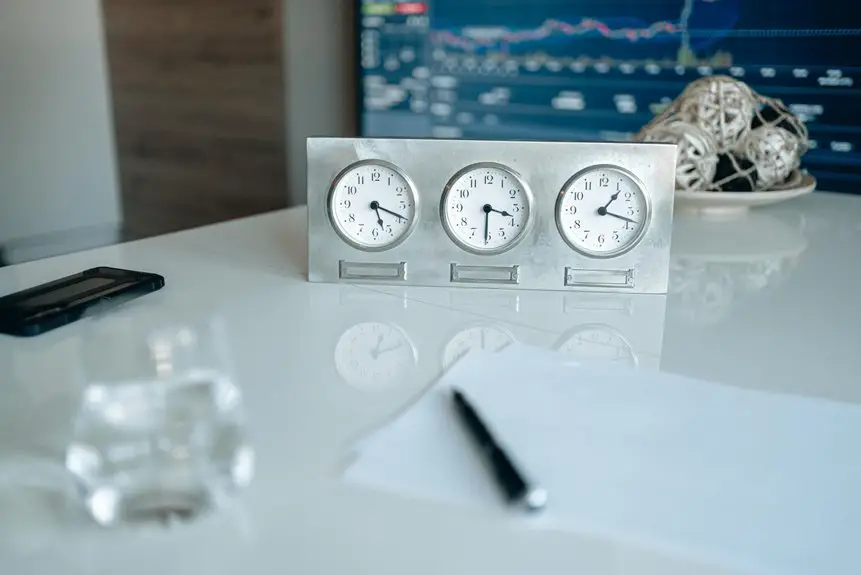The evolution of small clocks has been fascinating, starting with sundials and water clocks that measured time using shadows and water flow. As mechanical clocks emerged in the Middle Ages, they became essential for daily life. Pocket watches followed, allowing personal timekeeping. The Industrial Revolution made clocks widely accessible, while quartz technology and digital devices transformed time management. Today's smart clocks offer personalized features that enhance your lifestyle. There's much more to explore in this journey through timekeeping!
Table of Contents
Key Takeaways
- Ancient sundials and water clocks laid the foundation for timekeeping, using natural elements to measure hours during the day and night.
- Mechanical clocks emerged in the Middle Ages, providing greater accuracy and revolutionizing time management in daily life and commerce.
- The introduction of pocket watches in the late 16th century marked a shift toward personal timepieces, combining artistry and convenience.
- The Industrial Revolution facilitated mass production, making various clock styles, including wall and mantel clocks, more accessible to the public.
- Modern advancements, including quartz technology and smart features, have transformed clocks into multifunctional devices integral to daily routines.
The Origins of Timekeeping: Sundials and Water Clocks
As you explore the origins of timekeeping, you'll find that ancient civilizations relied heavily on sundials and water clocks to measure the passage of time.
Sundials used the sun's position, casting shadows on marked surfaces, allowing people to track hours during daylight. These simple instruments were essential for daily activities, agricultural planning, and religious rituals.
Sundials harnessed sunlight to cast shadows, enabling ancient societies to measure time for daily tasks and rituals.
On the other hand, water clocks, or clepsydras, measured time by the regulated flow of water from one container to another. They provided a more consistent method than sundials, especially at night or during cloudy days.
Both inventions reflected the ingenuity of early societies, shaping how they organized their lives around time. Understanding these tools gives you insight into humanity's quest for precision in timekeeping.
The Rise of Mechanical Clocks in the Middle Ages
As you explore the rise of mechanical clocks in the Middle Ages, you'll notice how they transformed timekeeping.
These innovations marked a significant leap in technology, leading to new advancements that shaped society.
You'll discover how the introduction of mechanical clocks influenced daily life and the organization of communities.
Origins of Mechanical Clocks
Although you might think of clocks as modern inventions, mechanical clocks actually began to emerge during the Middle Ages, transforming how people perceived and organized time.
These early devices, often powered by weight and gears, replaced unreliable methods like sundials and water clocks. You'd find them in monasteries and town squares, helping communities synchronize daily activities. The sound of bells not only marked the hours but also called people to prayer or work.
As craftsmanship improved, artisans developed more intricate designs, leading to greater accuracy. This shift allowed you to plan your day with newfound precision, influencing everything from agriculture to commerce.
The rise of mechanical clocks marked a pivotal change in society's relationship with time, shaping the future of timekeeping.
Advancements in Clock Technology
The emergence of mechanical clocks during the Middle Ages set the stage for remarkable advancements in clock technology. You'd see these innovative timepieces, powered by weights and gears, replacing less accurate sundials and water clocks.
As clockmakers experimented with various designs, they developed escapements, allowing for more precise timekeeping. You'd notice how these clocks began to incorporate intricate features like bells and decorative dials, showcasing artistry and engineering prowess.
The use of brass also became prevalent, enhancing durability and aesthetic appeal. By refining techniques such as spring-driven mechanisms, craftsmen paved the way for portability and personal use.
This era marked a significant turning point, as mechanical clocks transformed from large public installations to essential household items, revolutionizing how you perceive time.
Impact on Society
With the introduction of mechanical clocks in the Middle Ages, society experienced a transformative shift in how people organized their daily lives. You began to notice a newfound precision in timekeeping that affected everything from work schedules to religious practices.
Towns installed large clocks in public squares, allowing everyone to synchronize their activities, and you could finally plan your day around a consistent rhythm.
As a result, productivity increased, and the concept of punctuality took root. Communities started to embrace structured routines, leading to a more organized society.
This shift not only fostered economic growth but also influenced cultural developments, as people gathered for events and markets with a shared understanding of time. The mechanical clock truly changed your world.
The Advent of Pocket Watches: A Personal Timepiece
Pocket watches emerged as a personal timepiece that transformed how you kept track of time. Their origins trace back to the late 16th century, when they began to gain traction in society.
As you explored the growing popularity of these compact devices, you'd notice how they represented not just functionality but also status and style.
Origins of Pocket Watches
During the late 16th century, a remarkable shift in timekeeping emerged with the invention of the pocket watch, transforming how individuals perceived and managed their time.
These compact timepieces, initially designed for gentlemen, were a blend of artistry and functionality. They offered a new level of personal convenience, allowing you to carry time with you wherever you went.
Craftsmen meticulously crafted them, often incorporating intricate designs and valuable materials, making each piece unique. The pocket watch quickly became a symbol of status and sophistication, embodying the spirit of the Renaissance.
As you explore its origins, you'll appreciate how this innovation laid the groundwork for modern timekeeping, providing a glimpse into how personal timepieces would evolve in the centuries to come.
Popularity in Society
As the 17th century unfolded, pocket watches quickly gained popularity among the elite, revolutionizing the way people interacted with time. You could see these elegant timepieces adorning the waistcoats of nobles and merchants alike.
They weren't just tools for telling time; they became symbols of status and sophistication. You might imagine attending a lavish gathering where the soft ticking of pocket watches filled the air, each click a reminder of social standing.
As craftsmanship improved, these watches became more intricate, with designs that showcased artistry. By the 18th century, even common folk began to embrace pocket watches, making them a staple accessory.
This shift marked a significant change in how you perceived time, transforming it into a personal, wearable experience.
The Industrial Revolution and Mass Production of Clocks
Although the Industrial Revolution transformed many industries, its impact on clockmaking was particularly significant, ushering in an era of mass production that made timekeeping devices more accessible than ever. Gone were the days of handcrafted clocks; factories now churned out uniform designs at unprecedented rates.
| Clock Type | Production Method | Popularity Rating |
|---|---|---|
| Wall Clocks | Assembly Line | High |
| Pocket Watches | Machine-Made | Medium |
| Mantel Clocks | Mass Production | High |
| Alarm Clocks | Standardized Parts | Very High |
This shift not only reduced costs but also allowed you to enjoy a variety of styles and functionalities, forever changing how you perceive time.
The Transition to Quartz Movement and Battery-Powered Timepieces
With the advent of quartz technology in the late 20th century, clocks underwent another revolutionary transformation, making timekeeping even more precise and convenient.
Quartz movements use a small crystal that vibrates at a consistent frequency when an electric current passes through it. This innovation drastically improved accuracy compared to traditional mechanical movements.
Battery-powered timepieces became the norm, allowing you to enjoy hassle-free operation without winding. You could carry these lightweight, durable clocks anywhere, whether in your pocket or on your wrist.
The affordability of quartz watches also democratized timekeeping, making reliable timepieces accessible to everyone.
As you embraced this new era, your relationship with time evolved, blending functionality with style in ways previously unimaginable.
The Digital Era: Smart Clocks and Modern Innovations
The rise of digital technology has transformed clocks into multifunctional devices that do much more than just tell time.
Today's smart clocks seamlessly integrate into your daily life, enhancing convenience and connectivity. Imagine waking up to a gentle sunrise simulation, receiving reminders for appointments, and controlling your smart home devices—all from your clock.
- Personalized Alarm Sounds: Choose your favorite tunes or nature sounds to start your day on the right note.
- Health Monitoring: Track your sleep patterns and heart rate, helping you optimize your wellness routine.
- Voice Assistant Integration: Get instant answers to questions or play music, all with simple voice commands.
These innovations don't just keep you punctual; they enrich your lifestyle.
Frequently Asked Questions
How Have Small Clocks Influenced Daily Life Throughout History?
Small clocks've shaped your daily life by regulating routines, enhancing productivity, and enabling punctuality. They've transformed how you plan your day, attend appointments, and manage time, making life more structured and organized throughout history.
What Materials Were Used in Early Clockmaking Processes?
In early clockmaking, artisans used materials like wood, brass, and iron for gears and cases. They also incorporated glass for the faces. These components shaped the durability and functionality of timepieces throughout history.
How Do Different Cultures Perceive and Use Timekeeping?
Different cultures perceive timekeeping uniquely; for some, it's a strict schedule, while others embrace a more fluid approach. You'll notice how these perspectives shape daily life, rituals, and even the pace of work and leisure.
What Are the Environmental Impacts of Clock Production?
You'll find that clock production often involves resource extraction, energy consumption, and waste generation. Manufacturing processes can release harmful pollutants, impacting ecosystems and contributing to climate change, so considering sustainable practices is crucial for reducing these impacts.
How Do Small Clocks Contribute to Art and Design Today?
Small clocks enhance your space, combining functionality and artistry. You'll find unique designs that reflect personal style, from minimalist to elaborate, creating focal points in homes. They inspire creativity and serve as conversation starters in any setting.




